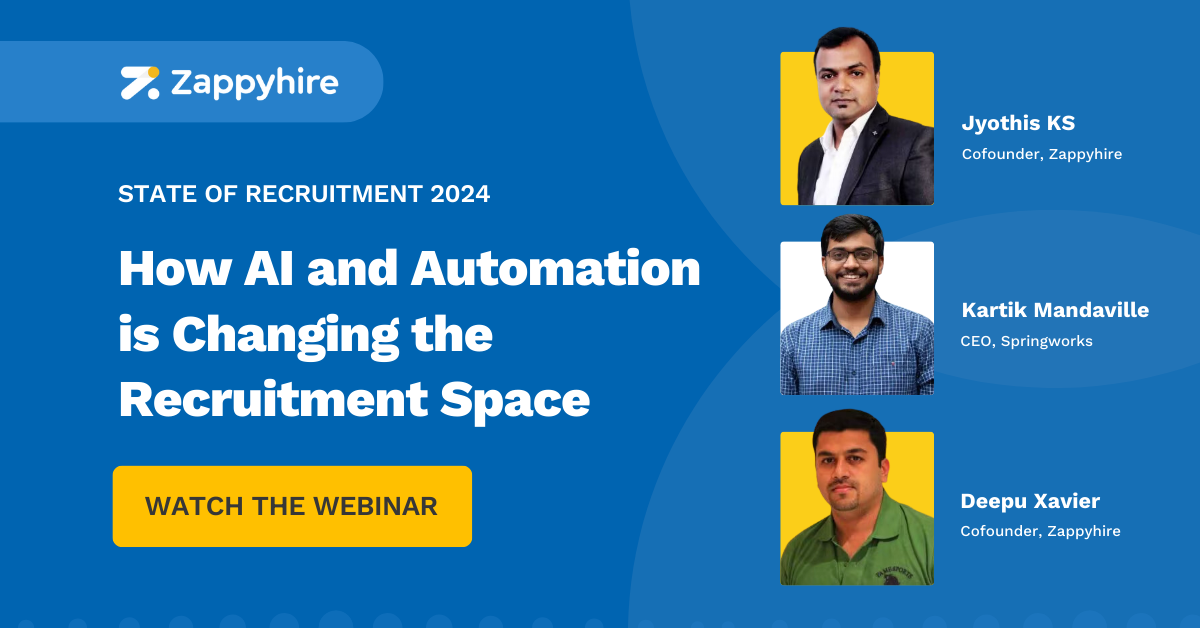
Research by McKinsey shows that in many organizations, 20-30% of critical roles remain unfilled by suitable candidates.
This presents a major challenge for medium and large companies, as a competent workforce is an imperative for long-term success.
But before we delve into how exactly organizations can achieve this, it is crucial to explore what exactly the catalysts for a successful organization are.
The formula is simple- a spectacular product or service, effective leadership, and an incredible workforce.
While all three are important yet challenging to achieve, it’s building an incredible workforce that often poses the greatest hurdle for talent acquisition teams.
Handling talent acquisition operations presents its own set of unique challenges. In this highly dynamic terrain, recruiters may feel like they have zero control from time to time.
The above is true because finding top talent quickly in a cutthroat competition isn’t easy even in the slightest.
In the same vein, compromising on the same is certainly not feasible, which is why it’s highly imperative for companies to have talent acquisition strategies in place.
What’s also important to note is that these strategies are not just about filling vacancies as soon as possible; there’s a whole process to it.
What it is actually about is having a tailored process for identifying, attracting, and hiring top quality talent to meet organizational needs.
This blog shall delve into the top 10 effective talent acquisition strategies for big companies, their complexities, and explore how they contribute to shaping an incredible workforce, ultimately driving organizational success.
Folks, get ready to take some notes!

What is talent acquisition?
Talent acquisition refers to the strategic measures set in place by organizations to identify and recruit the best (and the right) talent, with the ultimate goal of building a high-performing workforce.
It involves a systematic approach aimed at securing top talent, who are expected to make significant contributions directly or indirectly to the company’s overarching success.
Talent acquisition, encompassing workforce planning, involves strategically forecasting and planning to ensure the organization has the right personnel handy as and when needed.
If that’s the case, then how does talent acquisition differ from recruitment?
The key difference between recruitment and talent acquisition lies in the end goal.
While recruitment mainly focuses on filling vacancies at the earliest, sans specific strategies in place to ensure the quality of hire, talent acquisition places a greater emphasis on quality and “talent”.
Nevertheless, in the context of recruitment, quality definitely remains a priority but does not necessarily remain the primary concern or objective.
Importance of having an effective talent acquisition strategy

Strategies for talent acquisition play an integral role in shaping the success and sustainability of organizations and therefore their significance cannot be emphasized more.
These strategies offer scores of benefits that contribute to organizational growth, innovation, and provide large companies a competitive advantage.
Here’s a quick look at them:
1. Ensuring a competitive advantage:
A LinkedIn global recruiting trends report revealed that 57% of recruiters find competition for top talent one of the greatest challenges faced by their team.
To combat the same, it is crucial for organization’s to put their best foot forward in order to differentiate themselves from competitors to woo the best of the best candidates.
This is precisely where the implementation of talent acquisition and recruitment strategies come in, enabling organizations to acquire highly skilled individuals, thereby giving them a competitive edge in the market.
2. Facilitating organizational growth and innovation:
Effective recruitment and hiring practices help organizations grow by bringing in individuals with diverse skill sets, experiences, and perspectives.
This diversity propels creativity, problem-solving, and adaptability, enabling the company to advance and innovate.
Putting importance to diversity among decision-makers at board members and executive levels, ensures that diverse perspectives trickle down, inspiring positive change throughout the organization.
Infact, a study by McKinsey & Company observed that there is an increasingly clear connection between board diversity (the effort to ensure diversity among members of a board) and business performance, further driving home this point.
To reiterate, prioritizing diversity in decision making structures not only fosters innovation but also results in positive and tangible changes in the organization.
3. Building a diverse workforce:
It is crucial to note that talent acquisition strategies contribute to building a diverse workforce, which is integral for organizations to succeed.
As mentioned earlier, a diverse workforce brings together individuals from varied backgrounds and cultures, enriching the workplace and providing great opportunities for collaboration and creativity.
Focusing on building a diverse workforce also contributes to attracting great talent.
This becomes clear when we consider the following; approximately 32% of workers consider it very important to work in a diverse environment, embracing people of different races, ethnicities, ages, and genders.
4. Decreasing employee attrition rates:
Attracting and securing just any talent isn’t enough! Organizations must manage to retain them too!
By securing top-tier talent, these strategies may also help decrease employee attrition rates.
High employee turnover can be costly (to say costly is an understatement- it costs an average of $1,400 to onboard a new employee!) and significantly disruptive to organizational operations.
By investing the right and innovative talent acquisition strategies, these organizations in question can foster employee loyalty, engagement, and long-term commitment.
5. Decreasing hiring costs:
These tried and tested methods to find the best talent can contribute to decreased hiring costs by streamlining the recruitment process and decreasing an organization’s reliance on external recruitment agencies.
By leveraging internal talent pipelines, employer branding initiatives, and effective recruitment technologies, organizations can optimize their recruitment efforts and minimize unnecessary expenses.
6. Decreasing time-to-fill positions:
Strategies for talent acquisition aim to reduce the time-to-fill of open positions within the organization.
Did you know, SHRM’s research reveals that the average time-to-fill per position is approximately 33.28 days?
A lengthy hiring process (yes, 33.28 days is considered lengthy!) can result in lost productivity and missed opportunities.
By implementing efficient recruitment processes, like automating repetitive manual tasks in the recruitment pipeline and minimizing duplicate efforts, organizations can quickly identify and hire qualified candidates.
This thereby ensures that critical roles are filled in a timely manner.
On the whole, talent acquisition strategies are essential for large organizations looking to build a high-performing workforce in order to thrive in today’s hyper-competitive business environment.
Top 10 talent acquisition strategies to empower your talent team

1. Leverage talent acquisition and recruiting tools and technology:
One of the top and most effective strategies recruiters must consider implementing is the smart adoption of technology.
Today, in the digital age, not leveraging advanced talent acquisition and recruiting automation tools and technology would be a shame as the potential these technologies possess to transform your organization’s success is often overlooked!
99% of Fortune 500 companies use talent acquisition and recruiting automation tools. Coincidence? We think not.
It is crucial for organizations to stay competitive while hiring top tier talent, especially when top talent stays in the market for just a little over a week.
These tools that we’ve been referring to include talent acquisition suites, applicant tracking systems (ATS) and candidate relationship management (CRM) tools.
By making use of such tools, organizations can streamline the entire recruitment process, from sourcing and screening candidates to managing talent pipelines and making data-driven hiring decisions.
Additionally, the use of data analytics and predictive hiring models allows organizations to recognize talent trends, forecast future hiring requirements, and optimize recruitment strategies for better decision-making.
All this ultimately contributes to a significant improvement in the quality of hires made by the company.
2. Establish your employer brand:
An organization’s employer brand is its identity and reputation as an employer, encompassing its culture, values, mission, and employee value proposition.
Establishing a strong employer brand is crucial for building a high-quality workforce in today’s competitive job market.
A study revealed that organizations that invest in employer branding are 3X more likely to make a quality hire.
How can the big companies in question achieve this?
By developing a compelling employer brand strategy that resonates with prospective candidates and showcases the unique aspects of the organization’s culture and values.
It is crucial for companies to set themselves apart from the crowd as employers of choice and attract top talent who align with their values and vision.
This can be attained by effectively conveying the employer brand through employer branding campaigns, social media presence, and employee testimonials.
3. Use employee referral programs:
Did you know that close to 48% of businesses say their top quality hires come from employee referrals?
Employee referral programs are a powerful tool for sourcing qualified candidates through existing employees’ networks.
Well, what makes this practice so effective? Incentives!
These programs incentivize employees to refer their connections as prospective candidates for open positions by offering rewards for referrals that continue with the organization.
Additionally, by implementing employee referrals programs, organizations can tap into their employees’ networks to reach passive candidates who may not be actively seeking job opportunities.
The advantages of introducing employee referral programs don’t end there, they also contribute to higher employee engagement (which has the added benefit of making the organization 21% more profitable), morale, and retention.
This ensures that employees feel valued and engaged in the recruitment process.
4. Offer competitive salary and benefits:
By now it has become clear that talent acquisition is all about calculating offerings and gains for both the organization and the future employee.
It is therefore only natural that offering competitive salary and benefits packages is very important for procuring high-caliber employees.
By providing attractive compensation packages, organizations can position themselves as employers of choice and attract top talent who seek competitive rewards and opportunities for career growth and advancement.
To succeed with this, organizations must conduct comprehensive market research and benchmarking to ensure their compensation packages are competitive within the industry and market.
This includes not only base salaries but also bonuses, equity incentives, and non-monetary benefits such as healthcare, retirement plans, and flexible work arrangements (something that has gained traction in recent years).
5. Build outreach strategies:
The whole process of talent acquisition begins with formulating comprehensive outreach strategies, without which everything else becomes a futile exercise.
Building effective outreach strategies for talent acquisition and recruitment is extremely crucial for expanding the organization’s candidate reach and attracting diverse talent pools.
This involves developing a multi-channel approach that combines traditional and digital channels to reach potential candidates.
Organizations can also make use of targeted advertising campaigns, job boards, and social media platforms to promote job openings and employer brand messaging.
Additionally, strategic partnerships and collaborations with industry organizations, professional associations, and even diversity-focused groups can help access specific talent communities and networks.
Along with all of that, participating in industry conferences, career fairs, and networking events allows organizations to connect with potential candidates, build relationships, and showcase themselves as an employer of choice.
6. Foster a positive company culture:
Think like a highly skilled potential candidate- would you voluntarily consider a workplace that doesn’t have a positive company culture? The answer is likely to be no, although there might be exceptions.
But 77% of prospective employees would take a company’s culture into account before applying, suggestive of the fact that there are no two ways about it- cultivating a positive culture is an imperative if you want to attract the right candidates!
Fostering a positive company culture is essential for creating a supportive, inclusive and positive work environment that helps secure top candidates.
A strong organizational culture that values transparency, collaboration, diversity, inclusion, and employee well-being fosters employee engagement, satisfaction, and retention.
In addition to that, providing opportunities for ongoing learning and development, employee recognition, and career advancement supports employee growth and engagement.
Some ways to improve your organizational culture include- open communication channels, feedback mechanisms, and employee engagement surveys allow organizations to listen to employee feedback and address concerns.
7. Put diversity, equity, and inclusion (DEI) at the forefront:
Putting diversity, equity, and inclusion (DEI) at the forefront of the talent acquisition process is essential for creating a diverse and inclusive workplace.
Organizations must certainly integrate DEI principles and practices into all aspects of the recruitment process, from sourcing and screening to interviewing and hiring decisions.
This includes implementing diversity hiring strategies to attract, hire, and retain diverse talent, such as targeted outreach efforts, diversity-focused recruitment events, and partnerships with diverse organizations and communities.
Implementing bias-free recruitment practices, inclusive language in job postings, and diverse interview panels promotes fairness and equity in the hiring process.
By prioritizing DEI, organizations not only build diverse and inclusive teams but also foster innovation, creativity, and collaboration among employees from different backgrounds and perspectives.
8. Include and align recruiting goals with overall business goals:
Aligning recruiting goals with overall business objectives is crucial for ensuring that talent acquisition efforts contribute to the organization’s strategic success.
This ensures that organizations can focus their recruitment efforts on acquiring talent that is congruent with the company’s mission, vision, and values.
This involves developing recruitment key performance indicators (KPIs) and metrics to measure the effectiveness of recruitment efforts and their impact on business outcomes.
Collaborating with hiring managers and department heads to understand talent needs and develop tailored recruitment strategies ensures alignment with broader organizational objectives.
By aligning recruiting goals with overall business goals, organizations can drive sustainable growth, innovation, and success.
9. Networking and collaborations with educational institutions:
Networking and collaborations with educational institutions are valuable strategies for sourcing and nurturing talent pipelines.
In fact, employers have even identified networking (accounting for 27% of their recent hires) as an effective resource for finding quality candidates.
So how can organizations tap into the potential of networking and partnerships with educational institutions?
Participating in job fairs, networking events, and industry gatherings allows companies to connect with prospective candidates and establish relationships with educational institutions for future talent pipelines and potential partnerships.
Collaborating with universities, colleges, and vocational schools provides access to a pool of qualified candidates, including recent graduates and interns.
Furthermore, campus hiring initiatives offer opportunities for organizations to engage with students, showcase career opportunities, and build brand awareness among the future generation of talent.
10. Engage with passive candidates:
Here’s an interesting figure- 73% of candidates are passive job seekers!
With a figure like that, sidelining and not investing enough time and effort into engaging with passive candidates would be a grave mistake!
Engaging with passive candidates involves proactively reaching out to individuals who are not actively seeking job opportunities but may be open to the idea of exploring new career opportunities.
The implementation of this strategy however, requires personalized and targeted outreach, through various channels, including social media, professional networking sites, and direct communication.
Building relationships with passive candidates gradually over time through frequent communication, networking events, and rapport-building activities is essential for establishing trust, which is the end goal.
During such interactions, it is essential to highlight unique career opportunities offered by the company, the culture, and growth potential in order to capture the interest of passive candidates.
This thereby encourages them to consider your organization and grants companies access to a hidden talent pool (a gold mine).
It also expands the candidate reach well beyond active job seekers, ultimately leading to better quality hires and long-term success of companies.

In essence…
From leveraging technology to nurturing a positive company culture and prioritizing diversity and inclusion, these innovative talent acquisition strategies pave the way for organizational excellence.
It’s all about trial, error, and strategic mixing and matching, through which large organizations can tailor these approaches to best suit their unique requirements.
Having explored methods to effectively acquire highly talented individuals, why not put them into action?
Let’s start by scheduling a quick demo of Zappyhire’s highly advanced talent acquisition suite to see firsthand how it can enhance your recruitment efforts.






